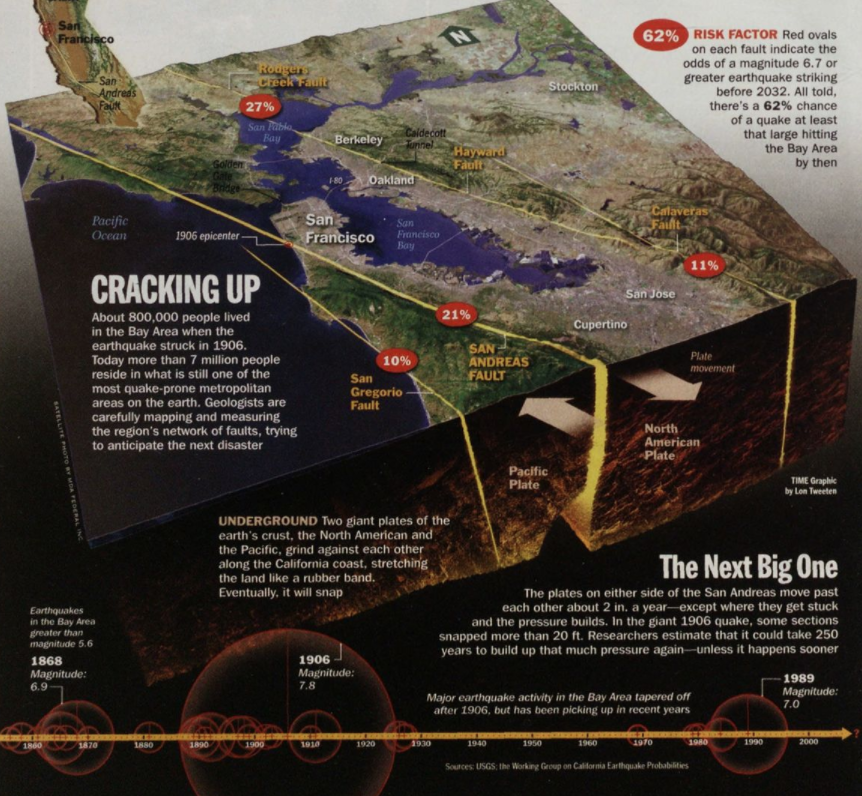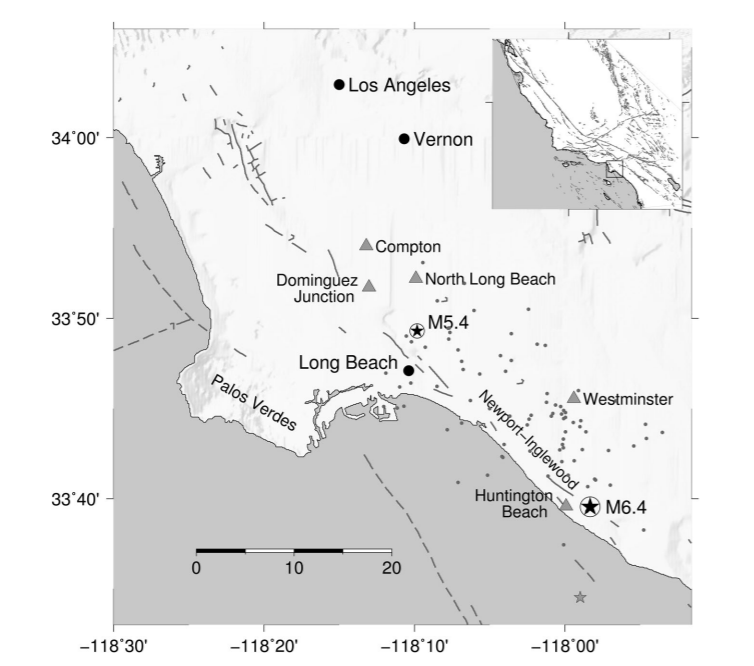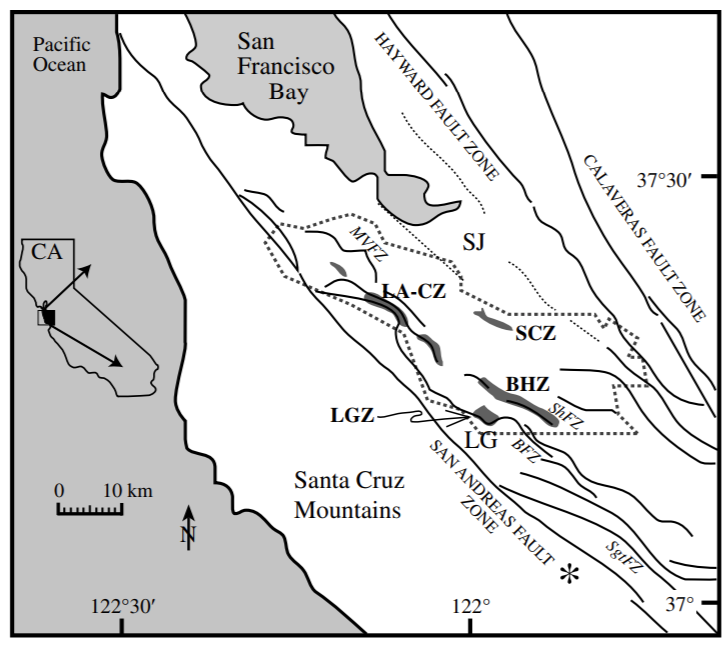Introduction
Humanity has long struggled against various natural disasters, including earthquakes, typhoons, floods, and other catastrophes. In California, earthquakes pose a particular problem due to geological processes and specific locations. Namely, the region is situated between the Pacific and the North American tectonic plates, which initiate countless earthquakes of different magnitudes (Wei-Haas par. 6).
The experts calculate that approximately every 3 minutes, an earthquake occurs in California (Wei-Haas par. 1). Fortunately, most of them go unnoticeable; however, several earthquakes in the 20th century claimed the lives of thousands of people. Some of the deadliest earthquakes in the selected period occurred in San Francisco in 1906, Long Beach in 1933, Loma Prieta in 1989, and Northridge in 1994. Therefore, it is essential to analyze these natural disasters and understand the causes of the tragedies. Ultimately, the current essay examines the most devastating earthquakes in California in the 20th century and proposes a hypothesis of when the next large earthquake might strike.
1906 San Francisco Earthquake
The largest and deadliest earthquake in American history occurred in San Francisco, California, on April 18, 1906. The natural disaster destroyed more than 28,000 buildings, resulted in approximately 3,000 deaths, and left 225,000 people homeless (Nash 58). The dimensions of the earthquake were so impactful that all communication lines, gas, and electrics malfunctioned and set the city on fire (Nash 58). Consequently, the fires and explosions destroyed most of the city (Nash 58). In the early 2000s, people were still holding annual events celebrating San Francisco’s endurance (Ellison 64). In 2005, there were only six survivors left; however, the community made sure that the tragedy was not forgotten and that Californians should be prepared for future earthquakes (Ellison 64). Ultimately, it was the most devastating earthquake to ever occur on the territory of the United States, and no one could explain its causes at the time.
However, shortly after the earthquake, a group of geologists examined the region and revealed the cause of the tragedy. They found a fault line located parallel to the coast that span for over 700 miles, which they later named the ‘San Andreas Fault’ (Nash 58). In seismology, a fault refers to the discontinuity of the rock-mass movement, and a fault line is a surface representation of a fault (Williams par. 2). This discovery was crucial to the geology and seismology fields and allowed making groundbreaking progress in understanding earthquakes. Namely, the same group of geologists led by Andrew Lawson developed the elastic-rebound theory (Nash 58). In general, the model suggests that the energy built on the opposing sides of the fault exceeds its limits, and the ground snaps (Nash 58). As a result, the 1906 earthquake was the consequence of the two plates on different sides of the San Andreas Fault movement and the eventual energy release (Nash 60). The chart demonstrating the major faults in the area is presented below in Fig. 1. Ultimately, the after-effects of the 1906 earthquake were terrible; however, it provided essential information about the natural disaster.

The obtained knowledge about earthquakes and developed theories allow experts to estimate the approximate frequency of earthquakes and, thus, prepare for them. The first significant consequence is that earthquakes generally occur in cycles, making it possible to predict the next occurrence (Nash 60). For instance, the tectonic plates around the San Andreas fault move approximately two inches per year in different directions (Nash 60). Therefore, according to the elastic-rebound theory, the energy in the Earth’s crust accumulates, and another large earthquake should be expected in California in the foreseeable future (Nash 60). Furthermore, based on the article, the experts believe that there is approximately a 60% chance of a large-scale earthquake striking the Bay Area before 2032 (Nash 60). The prevalence of faults in the region clearly indicates this possibility, and the necessary countermeasures should be implemented. Ultimately, the earthquake in San Francisco in 1906 not only demonstrated the destructive force of natural disasters but also provided invaluable information that humanity should use to prevent the repetition of the tragedy.
1933 Long Beach Earthquake
Even though the San Francisco earthquake in 1906 is generally recognized as the most devastating one in American history, a large number of smaller ones also occurred in California in the 20th century. The following large earthquake in California was the Long Beach earthquake in 1933 – the largest earthquake in the central Los Angeles Basin region (Hough and Graves 1). The map in Figure 2 below demonstrates the rupture location and the after-effects in the adjacent areas.

The death toll and financial damage were significantly lower compared to 1906, accounting for 120 fatalities (Hough and Graves 1). According to the moment magnitude scale, the earthquake reached 6.43Mw and included two sub-events deriving from the mainshock (Hough and Graves 1). At present, the innovative approaches allow analyzing instrumental and macroseismic data of the earthquake to a great extent (Hough and Graves 8). Nevertheless, the tragedy occurred almost 80 years ago; thus, there are not many credible sources left about the details of the earthquake.
From these considerations, the experts utilize any data of potential interest, including newspaper articles, photos, and reports. Furthermore, the investigation is complicated by the fact that the earthquake did not rupture the surface; therefore, there was little visual evidence (Hough and Graves 1). The earthquake is generally associated with the Newport-Inglewood fault (NIF); however, various studies demonstrated diverse evidence of causes with no affirmative conclusions (Hough and Graves 1). Ultimately, many factors complicate the accurate analysis of the tragedy, but the general consensus supports the NIF theory.
Nevertheless, even the limited data about the earthquake might be used to understand the nature of the tragedy and mitigate its repetition. The recent research transparently demonstrates that innovative methods, such as the broadband computational simulation approach, might provide curious insights (Hough and Graves 3). Thus, the study by Hough and Graves (2020) calculates the ground and upward velocities to create a simulation model of the earthquake. This approach allows to more accurately locate the epicenter of the rupture and explain the distribution of the consequent sub-events (Hough and Graves 6). As a result, the study confirmed the NIF theory and demonstrated the potential of modern technology to indicate the source of the earthquakes.
1989 Loma Prieta Earthquake
One of the consequent large-scale natural disasters in California was the Loma Prieta earthquake in 1989. The earthquake with a moment magnitude of 6.9 Mw resulted in the ground deformation of approximately 663 km2 and 60 deaths (Schmidt et al. 1177). Most of the damage was noticed in the Santa Clara Valley, with sub-events occurring in the adjacent areas (Schmidt et al. 1177). The schematic map below in Figure 3 demonstrates the geographic terrain around the Santa Cruz Mountains:

The Santa Clara Valley is surrounded by a large number of fault zones, including major ones, such as San Andreas and Hayward, and smaller ones, such as Shannon, Berrocal, and Monte Vista. The density of faults explains the destructive force of the earthquake and the associated casualties.
Furthermore, similar to the evaluation methods of the Long Beach earthquake, the experts utilized a wide array of information sources, including reports and visual information. In the case of the 1989 earthquake, the latter is particularly significant since the earthquake caused notable damage to pavement and utility pipes (Schmidt et al. 1177). Therefore, despite the lack of surface rupture, it is possible to analyze the extent of the disaster by its collateral damage. Schmidt et al. (2014) analyzed 1427 damaged sites primarily focusing on the utilities located close to the surface, such as pavements, storm drains, and pipes. The analysis revealed the rupture site and depth, which, in turn, helped experts to indicate the location of active faults (Schmidt et al. 1199). This information is invaluable to predicting any future occurrences in the region and providing appropriate countermeasures.
1994 Northridge Earthquake
Lastly, the current essay examines the Northridge earthquake that occurred on January 17, 1994. The disaster took the lives of approximately 60 people and caused nearly $20 billion in financial damage (Palmer 24). The moment magnitude of the earthquake was Mw 6.7, which is similar to the measurements demonstrated by the 1933 and 1989 disasters (Han et al. 2). The rupture was estimated to be active from approximately 17.5 km to 5km beneath the surface, and there was no surface rupture (Han et al. 2). The map indicating the epicenter and the nearby control stations is presented below in Figure 4:

Unlike the prior periods, the concrete buildings in the greater Los Angeles area were constructed according to the new standards of earthquake safety, which helped to mitigate the damage (Palmer 24). Nevertheless, even the said regulations could not nullify the destruction, and the UBC implemented new additions to the concrete building safety protocol in 1996 (Palmer 26). Some of the changes include the adjustment of reinforcement, stricter requirements for frames, and the elimination of any irregularities that could deteriorate the safety metrics of the building (Palmer 26). Nevertheless, even at present, there is a large number of pre-1980 buildings in the regions with active fault zones (Palmer 26). Therefore, despite the increasing awareness of earthquake risks, the next large earthquake might cause irreversible damage and pose a specific danger to people living in old buildings. It is a highly relevant issue, particularly due to the prognosis that an earthquake of a similar scale to the 1906 disaster might occur in California relatively soon.
Causes: California Fault Line
Having discussed the specific earthquakes in American history, it is essential to examine the primary causes of the natural disaster. Some of the key terms to understanding earthquakes are a fault and a fault line. As mentioned before, the former generally refers to the discontinuity of the rock-mass movement (Williams par. 2). The latter concerns the representation of the fault on the surface level, clearly indicating the fracture of the Earth’s crust (Williams par. 2). The faults commonly occur as a consequence of tectonic plate movement and their friction, which eventually results in seismic activity or earthquakes (Williams par. 6). However, the primary problem is the accurate identification of active faults and judgment of tectonic plates movement.
The issue is further complicated by the abundance of hidden faults, which are immensely difficult to locate before their activation. The experts attempt to discover such spots by sending vibrations and pulses into the ground and looking for a reflection response (Svitil 64). This approach potentially allows identifying hidden faults in the Los Angeles Basin to make better preparation for the following earthquakes (Svitil 64). This method is not yet perfected, and there is a margin for error; nevertheless, it might help to moderate the damage caused by future earthquakes. Ultimately, the high frequency of earthquakes in California is attributed to its location in the active fault zone. San Andreas Fault, San Gregorio Fault, Hayward Fault, Calaveras Fault, and many others located roughly between the Pacific Plate and the North American Plate are the primary causes.
Richter Scale
Lastly, it is essential to examine the contemporary methods of earthquake risk and destructive force evaluation. One of the most effective systems is the Richter magnitude scale and its latest iteration – the moment magnitude scale. At present, the latter is the industry-standard scale that provides the most accurate measurements of earthquake destructive force; however, the media generally perceives all earthquake evaluation methods as Richter scale. This phenomenon is explained by the vast significance of initial Richter’s invention in 1932 and its impact on seismology (Hough 112). The scale itself utilized a logarithmic approach to calculate amplitudes due to the potential for more accurate measurements (Hough 117). In other words, the logarithmic scale simply allowed for a less complex evaluation system of the exponentially increased strength of earthquakes. For instance, the destructive force of an earthquake with a magnitude of 5 is ten times more powerful than that with a magnitude of 4 (Hough 118). Thus, the logarithmic approach is used for convenience since it is much easier for people to comprehend a 1-10 scale than a 1-10000 system.
Conclusion
The current essay has examined four prominent earthquakes that occurred in California in the 20th century and demonstrated the uncertain nature of earthquakes. Nevertheless, the said tragedies allowed experts to learn invaluable information about the causes of earthquakes and the potential methods to predict the occurrences. California’s largest and deadliest earthquake in the 20th century was the 1906 San Francisco tragedy, which caused more than 3,000 deaths. Unfortunately, experts predict that an earthquake of a similar scale might occur soon within a 20-year old period due to the cyclical nature of earthquakes (Nash 60). Despite the best efforts of research groups, innovative technologies, and new safety construction regulations, the risks posed by an earthquake of such a scale are immense. It is highly possible that the damage from the next earthquake will be less than the 1906 analog due to technological improvement; however, preparing for the worst is vital.
Works Cited
Ellison, Katherine. “Survivor Tales.” Smithsonian, vol. 37, no. 1, 2006, pp. 64.
Han, Lu, et al. “Identification of Pulse-Like Ground Motions during the 1994 Northridge Earthquake.” IOP Conference Series: Earth and Environmental Science. Vol. 787. No. 1. IOP Publishing, 2021.
Hough, Susan, and R. W. Graves. “The 1933 Long Beach Earthquake (California, USA): Ground Motions and Rupture Scenario.” Scientific Reports, vol. 10, no. 10017, 2020, pp. 1-10.
Hough, Susan. Richter’s Scale (Measure of an Earthquake, Measure of a Man). Princeton University Press, 2016.
Nash, Madeleine. “April 18, 1906: Lessons from the Earthquake that Shook the World.” TIME Magazine, Web.
Palmer, Keith. “Northridge: 25 Years Later.” Structure Magazine, Web.
Schmidt, Kevin, et al. “Deformation from the 1989 Loma Prieta earthquake near the southwest margin of the Santa Clara Valley, California.” Geosphere, vol. 10, no. 6, 2014, pp. 1177-1202.
Svitil, Kathy. “L.A.’s Hidden Faults.” Discover, vol. 16, no. 1, 1995, pp. 64.
Wei-Haas, Maya. “Every Three Minutes, an Earthquake Strikes in California.” National Geographic, Web.
Williams, Matt. “What is Earthquake Fault Lines?” Universe Today, Web.